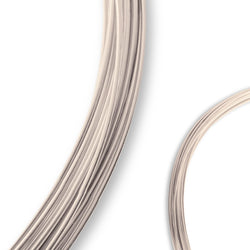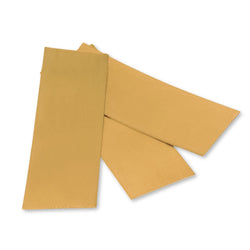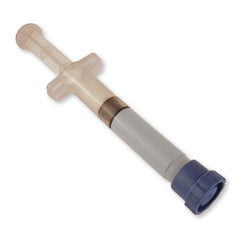Schmucklot
Werten Sie Ihre Schmuckkreationen mit unserem professionellen Schmucklot auf, das darauf zugeschnitten ist, Ihren Designs Haltbarkeit und Brillanz zu verleihen.
Wählen Sie aus unserem vielseitigen Sortiment, das in Draht- , Blech- und Pastenform erhältlich ist, um starke Verbindungen und ein makelloses Finish zu gewährleisten.
Ganz gleich, ob Sie ein erfahrener Juwelier in Sydney oder ein handwerklicher Liebhaber in Melbourne sind, hier finden Sie das perfekte Lot für Ihre Projekte.
Lötzinn für jedes Schmuckprojekt
Unsere umfangreiche Auswahl an Lötmaterialien erfüllt die Anforderungen aller Schmuckherstellungsunternehmen. Der Lötdraht ist ideal für präzises Arbeiten und bietet Kontrolle und Effizienz. Plattenlot bietet eine breite Abdeckung größerer Flächen und sorgt so für gleichmäßige Verbindungen. Aufgrund der Benutzerfreundlichkeit und des außergewöhnlichen Fließverhaltens ist unser Pastenlot die erste Wahl, perfekt für detaillierte Aufgaben, bei denen es auf Präzision ankommt.
Wir wissen, wie wichtig Qualität ist. Unsere in Silber, Gold und anderen Legierungen erhältlichen Lote sind darauf ausgelegt, nahtlose Verbindungen herzustellen und Ihren Teilen die Integrität zu verleihen, die sie verdienen.
Häufig gestellte Fragen
Solder is a metal alloy used in jewellery making to join two or more metal pieces together. It melts at a lower temperature than the metals being joined, creating a strong bond when it cools and solidifies.
Soldering is essential for various tasks like attaching jump rings, creating bezels, and repairing broken jewellery.
There are several types of solder used in jewellery making, including silver solder, gold solder, and platinum solder. These come in different forms such as hard, medium, and easy, each melting at different temperatures to accommodate various stages of the soldering process.
The difference between hard, medium, and easy solder lies in their melting points. Hard solder melts at the highest temperature, making it ideal for the initial stages of assembly. Medium solder has a mid-range melting point, while easy solder melts at the lowest temperature, perfect for final joins without disturbing previous solder work.
Solder melting temperatures vary depending on the type and hardness. For example, silver solder melts between 620°C to 770°C (1148°F to 1418°F), while gold solder melts between 710°C to 950°C (1310°F to 1742°F). It’s crucial to match the solder’s melting point to your project’s needs.
For beginners, easy solder is often the best choice due to its lower melting point, making it easier to work with. Silver solder in easy grade is commonly recommended for its versatility and ease of use, allowing beginners to practice without damaging their pieces.
Choosing the right solder depends on the metals you are working with, the type of join you need, and the stage of your project. Use hard solder for initial joins and easy solder for final joins. Match the solder’s metal type (silver, gold, etc.) to your base metal for compatibility and a seamless finish.
Das Löten von Schmuck zu Hause erfordert eine sorgfältige Vorbereitung und die richtigenWerkzeuge . Beginnen Sie mit einer sauberen, feuerfesten Arbeitsfläche und stellen Sie Ihre wichtigsten Lötutensilien bereit: einen Brenner , Lötzinn, Flussmittel , Beizlösung und Sicherheitsausrüstung. Nachdem Sie Ihre zu lötenden Teile positioniert haben, tragen Sie Flussmittel auf, um Oxidation zu verhindern und einen gleichmäßigen Lotfluss zu ermöglichen. Schneiden Sie ein kleines Stück Lot ab und platzieren Sie es in der Nähe der Verbindungsstelle. Erhitzen Sie beide Teile gleichmäßig, bis das Lot fließt und die beiden Teile miteinander verbunden sind. Anschließend das Stück abschrecken und einlegen, um eventuelle Rückstände zu entfernen.
Die Entscheidung, ob Sie bei der Schmuckherstellung Draht-, Blech- oder Pastenlot verwenden, hängt von den spezifischen Anforderungen Ihres Projekts und Ihren Kenntnissen der Löttechniken ab.
Drahtlot wird wegen seiner einfachen Handhabung und Präzision oft bevorzugt; Es eignet sich hervorragend, um in enge Räume zu gelangen und filigrane Verbindungen herzustellen. Für komplizierte Arbeiten, etwa beim Anbringen von Befunden oder bei detaillierten Metallarbeiten, kann Drahtlöten die beste Wahl sein. Australische Juweliere entscheiden sich aufgrund der Vielseitigkeit und Kontrolle häufig für Drahtlot.
Blechlot bietet einen Vorteil, wenn größere Flächen eine gleichmäßige Abdeckung erfordern oder wenn Sie für gleichmäßige Verbindungen exakte Mengen abschneiden müssen. Lotplatten können auf die richtige Größe zugeschnitten werden, sodass Juweliere genau die Menge verwenden können, die sie benötigen, wodurch der Abfall minimiert wird. Diese Form eignet sich besonders für Aufgaben, bei denen mehrere Teile gleichzeitig zusammengefügt werden müssen.
Pastenlot hingegen wird bereits mit Flussmittel geliefert und ist eine praktische Option für Anfänger oder für diejenigen, die an komplexen Teilen arbeiten, bei denen das Platzieren von Draht oder Lotblech schwierig ist. Die Paste kann direkt auf die Fuge aufgetragen werden und ist bei Produktionsarbeiten einfach zu verwenden, sodass ein gleichmäßiger Auftrag mit minimalem Reinigungsaufwand gewährleistet ist.
Jeder Typ hat seine eigenen Vorteile und die beste Wahl hängt oft von den persönlichen Vorlieben und den Besonderheiten der Schmuckstücke ab, die Sie herstellen. Unser Zubehör für die Schmuckherstellung bietet eine Reihe von Lötoptionen für unterschiedliche Fähigkeiten und Projektanforderungen und stellt sicher, dass Sie das perfekte Produkt für Ihre Arbeit finden.
Berücksichtigen Sie immer die Schmelztemperatur und die Fließeigenschaften des von Ihnen gewählten Lots, um sicherzustellen, dass es effektiv zu den Metall- und Designdetails Ihres Schmuckstücks passt.
Flux is a chemical compound applied to metal surfaces before soldering to prevent oxidation and ensure the solder flows smoothly. It helps create clean, strong bonds by keeping the metal surfaces clean and free from contaminants during the soldering process.
Safety precautions for soldering jewellery include working in a well-ventilated area, wearing protective eyewear and gloves, and using a heat-resistant surface. It’s also important to keep flammable materials away from your workspace and to use a fume extractor if possible.
Essential equipment for soldering jewellery includes a soldering torch, soldering block, flux, solder (wire, sheet, or paste), tweezers, a pickling solution for cleaning, and protective gear such as safety glasses and gloves.
Bei der Auswahl von Lot für Schmuck hängt die Auswahl in der Regel von der Art des Metalls ab, mit dem Sie arbeiten. Für Goldschmuck würden Sie ein Goldlot verwenden, während für Silberstücke ein Silberlot am besten geeignet ist.
Es ist auch wichtig, die Schmelztemperatur und die Fließeigenschaften (leicht, mittel oder hart) zu berücksichtigen, um sicherzustellen, dass sie den Herstellungsprozess Ihres Schmuckstücks ergänzen.
Das Löten von Schmuck ist sicher, wenn die entsprechenden Sicherheitsprotokolle befolgt werden. Da dabei mit hoher Hitze und potenziell gefährlichen Materialien gearbeitet wird, sind eine angemessene Belüftung, hitzebeständige Oberflächen, Schutzbrillen und Handschuhe unerlässlich.
Es ist auch wichtig, über den Lötprozess informiert zu sein und die Materialien zu verstehen, mit denen Sie arbeiten.
After soldering, clean up your jewellery piece by quenching it a pickling solution to remove any oxidation and flux residue. Rinse thoroughly and polish the piece to restore its shine.
Solder wire, sheet, and paste differ in form and application. Solder wire is versatile and easy to control, solder sheet is great for precise cutting into custom shapes, and solder paste is ideal for small, detailed work where control is essential.
The best solder for silver jewellery is silver solder, available in hard, medium, and easy grades. Easy silver solder is commonly used for its lower melting point, making it ideal for most silver jewellery projects.
For gold jewellery, gold solder is the best option. It is available in different karats to match the purity of the gold you’re working with. Use 14k or 18k gold solder, depending on the gold content of your jewellery piece.
Technically Yes, silver solder can be used on gold, however it is unadvised as the bond will not be strong and it will leave a visible seam. It’s best to use gold solder for a seamless finish that matches the colour and purity of the gold.
The best solder for platinum jewellery is platinum solder, which has a high melting point to match platinum’s durability. It ensures a strong bond and a consistent finish with the platinum metal.
Gold solder is made of a combination of gold, silver, copper, and sometimes zinc, depending on the karat and colour. The alloy is designed to match the colour and melting point of the gold being worked with.
For repairing broken jewellery, use a solder that matches the metal of the piece. Medium silver or gold solder wire is ideal for repairs because of its balance of low melting point and strength, which minimises the risk of damaging the surrounding metal, and provides long term durability.
To prepare metal for soldering, clean the surfaces thoroughly with a file or sandpaper to remove any oxidation or dirt. Apply flux to the joint to prevent further oxidation and ensure a smooth flow of solder.
To prevent solder from flowing where you don’t want it, be careful and selective with your flux and use a small amount of solder to control the flow. Position the piece carefully so gravity works in your favour, and use heat strategically to direct the solder flow - Solder will flow in the direction where there is most heat!
Avoid melting your jewellery by using a flame that’s appropriate for the metal’s melting point and by applying heat gradually. Keep the torch moving to distribute the heat evenly and avoid focusing on one spot for too long.
The best way to solder jump rings is to first close the ring tightly, apply flux, and then heat the ring evenly with a torch. Apply a small amount of solder to the seam and let it flow to join the ends seamlessly.
To solder a chain, secure the links that need soldering on a heat-resistant surface, apply flux, and use a torch to heat the area. Apply a small piece of solder and allow it to flow into the joint, then cool and clean the chain. Use a small flame to avoid heat spreading to unwanted areas. Also consider using cross locking tweezers to isolate the soldering area and absorb excess heat from being distributed through other chain links.
To fix a broken solder joint, re-clean the area, apply flux, and reheat the joint with a torch. Add a small amount of solder to fill the gap and ensure a strong bond, then pickle and clean the piece.
Solder may not flow if the metal isn’t clean, the flux has burned off, or the piece isn’t hot enough. Ensure that the metal is clean, reapply flux if needed, and heat the entire joint evenly.
Solder balls up when the metal isn’t hot enough or when there’s a lack of flux. Make sure the metal reaches the correct temperature, and apply sufficient flux to help the solder flow smoothly.
To remove excess solder, file or sand the area carefully until it’s flush with the surrounding metal.
Improve your soldering skills by practising on scrap metal, learning to control the heat, and understanding the properties of different solders and metals. Experiment with different techniques, and always prepare your work area and materials thoroughly.
This specialised method involves pre-positioning small amounts of solder onto one of the pieces to be joined. Then, heat is applied to the opposite side of the metal, causing the heat to transfer through the piece and melt the solder, creating a secure bond.
Laser soldering uses a focused laser beam to heat and join small areas of metal with precision. It’s ideal for delicate work where traditional torches might cause damage, and it’s commonly used in high-end jewellery making.
Yes, you can solder at home with the right tools and safety precautions. Ensure you have a well-ventilated workspace, a soldering kit, and protective gear. Always follow safety guidelines to avoid accidents.
You can buy jewellery solder from various suppliers, including online retailers and specialised jewellery supply stores. However, Ore Metals stands out as the premier choice due to our superior quality and extensive range of options.
Store solder in a cool, dry place to prevent oxidation. Keep it in airtight containers or zip-lock bags with anti-tarnish strips to maintain its quality. Label different solders to avoid confusion.



